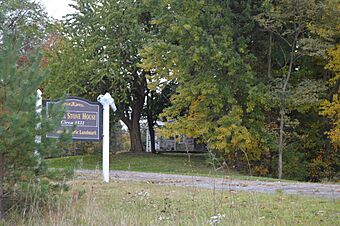Judge William Shaw Anderson House facts for kids
Quick facts for kids |
|
|
Judge William Shaw Anderson House
|
|

Roadside view of the Judge William Shaw Anderson House, located at 7171 Mahoning Avenue in Austintown Township, Mahoning County, Ohio, United States. Built in 1830, it is listed on the National Register of Historic Places.
|
|
| Location | 7171 Mahoning Ave., Austintown, Ohio |
|---|---|
| Architect | William Strock |
| Architectural style | Federal and Classical Revival |
| NRHP reference No. | 76001479 |
| Added to NRHP | 1976-03-17 |
The Judge William Shaw Anderson House is a historic building in Austintown, Ohio. It is also known as the "Strock Stone House." This special house was added to the National Register of Historic Places on March 17, 1976. It has a long and interesting history, serving as a family home for many years.
Contents
A Look at the Strock Stone House
The Strock Stone House is famous for its unique construction. It was built using very large blocks of sandstone. Some of these stones weighed as much as 750 pounds! That's like the weight of a small car. The stones came from a place called Stony Ridge, not far from the house.
Who Lived Here First?
The house was built around 1831. Even though a man named William McClure might have built it, the first family to live there was William Strock and his family. William Strock was born in Pennsylvania in 1801. His family moved to Austintown around 1813 or 1815.
William Strock became a carpenter. He bought about 87 acres (35 hectares) of land in 1830. This is where he had the house built for his family.
A Stop on the Underground Railroad?
In 1851, William Strock sold the house to Francis Henry. Francis Henry was part of a religious group. It is believed that the Strock Stone House was a stop on the Underground Railroad. This was a secret network that helped enslaved people escape to freedom in Canada.
While it's hard to prove every stop, there are clues that support this idea:
- Austintown was known as part of the Underground Railroad's path.
- William Strock's brother, John Henry Strock, was an early supporter of ending slavery.
- Francis Henry is listed as someone who helped with the Underground Railroad in Mahoning County.
- Some stories say enslaved people were hidden in a secret tunnel. This tunnel supposedly connected the house basement to the barn.
Francis Henry lived in the house with his wife, Mary, and their four children.
The Anderson Family Takes Over
In 1863, Francis Henry sold the house to David Anderson. David Anderson came from Northern Ireland and moved to Philadelphia in the 1830s. He later came to Austintown and opened a general store. David Anderson became one of the wealthiest people in Austintown Township.
David and his wife, Hannah L. Shaw Anderson, had four children. After Hannah passed away in 1879, David Anderson reportedly let the house fall into disrepair. He moved to a different house nearby. The Strock Stone House was even used as a shelter for animals for a time.
The Judge's Home
In 1890, David Anderson's oldest son, William Shaw Anderson, took over the property. William Shaw Anderson was a well-known lawyer and judge. He used the Strock Stone House as a summer home at first. He lived in the house from 1890 to 1925. It is even said that President William McKinley visited him at the house!
William Shaw Anderson and his wife, Louise Shields Anderson, had four children. Judge Anderson worked to restore the house. Between 1912 and 1918, he made many additions. These included:
- A sun porch
- A dining room and a small eating area
- Three new bedrooms and a bathroom upstairs
- A larger basement
- Central heat was also added to the house.
At this time, the property also had many other buildings. These included barns, a pump house, a poultry house, a milk house, and an ice house.
The House Today
After Judge Anderson passed away in 1925, his children, Randall H. and Blanche Anderson, owned the house. In 1929, they sold it to the Mahoning Valley Sanitary District (MVSD). The house was then used as the home for the Chief Engineer of the MVSD until 1985.
Today, the Austintown Historical Society takes care of the Strock Stone House. They get help from the Mahoning Valley Sanitary District. The Society has furnished the inside of the house with old rugs and furniture. These items were donated by people in Austintown. There is even a special quilt from South Carolina on display.
What You Can See Inside
When you visit the Strock Stone House, you can see many interesting things:
- The basement has a collection of old washing machines.
- The parlor (a formal living room) has antique furniture, including an organ.
- One bedroom is set up with old children's games and clothing.
- Another room is a lady's bedroom. It has antique clothes like a wedding dress, coats, and old swimsuits.
- The man's bedroom has old men's clothing and travel trunks from the 1890s.
- The quilting room shows how quilts were made. It has an antique quilt rack, a treadle sewing machine, and old irons.
- The office room has an antique printing press and old typewriters. You can also see old ledger books from local grocery stores.
The back porch is set up like a summer kitchen. It has an old stove, antique dishes, and canning jars.
The house is open for free guided tours. You can visit on the first Sunday of every month from March to December, between 1 PM and 3 PM. You can also make an appointment for other times.



